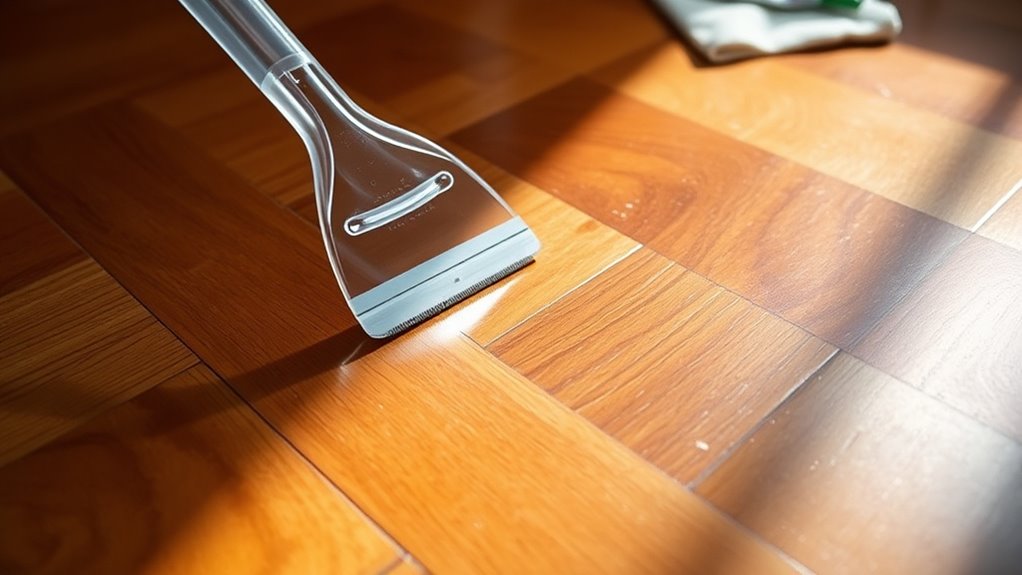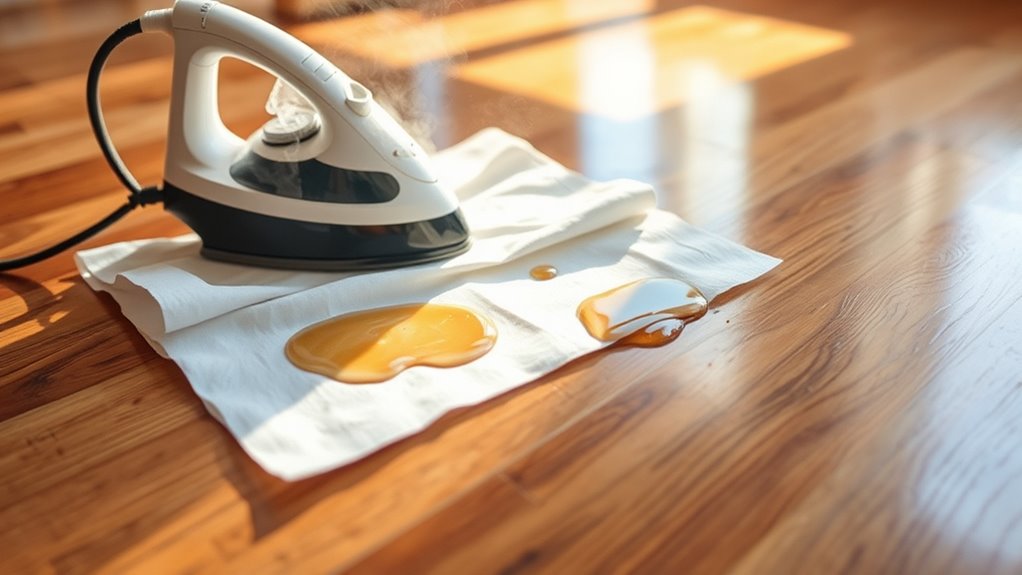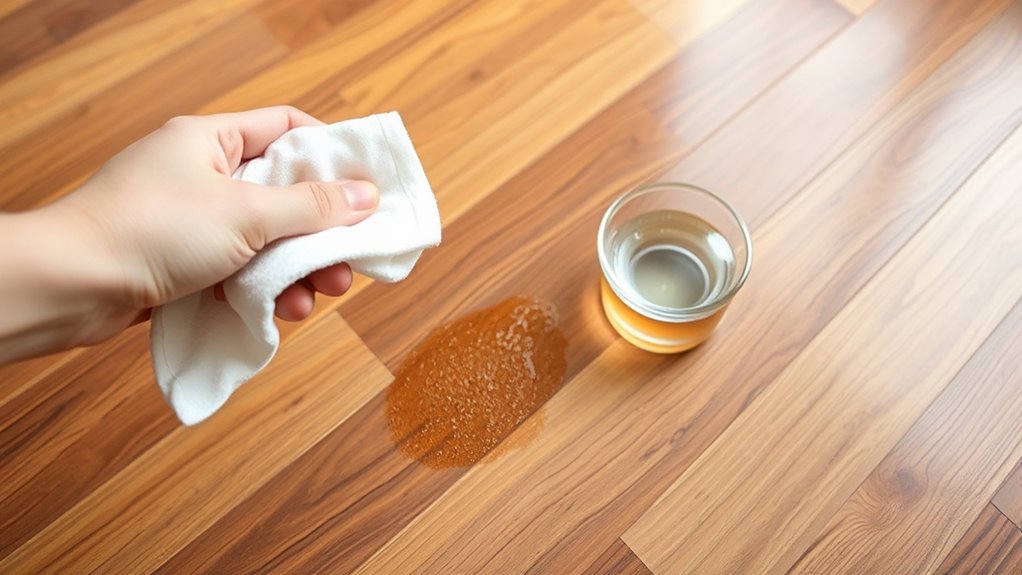To quickly remove wax from hardwood floors, first identify the wax type to choose a safe method. Use a plastic scraper with gentle pressure to lift softened wax, applying low heat from a hairdryer or an iron with a protective cloth to soften it without damaging the wood. Avoid excess moisture, test methods on hidden spots, and clean residue with a hardwood-safe cleaner. Following these precise steps guarantees floor safety and restoration. Explore further tips to protect and maintain your floors’ finish.
Identifying the Type of Wax on Your Hardwood Floor

How can you tell what type of wax is on your hardwood floor before starting the removal process? Begin by examining the wax characteristics: is it soft and pliable or hard and brittle? Common types of wax include paste wax, which feels thick and creamy, and liquid wax, which tends to be thin and glossy. You can test a small hidden area by rubbing it with a soft cloth dampened with mineral spirits; if the wax dissolves easily, it’s likely a solvent-based wax. Water-based waxes won’t react this way. Identifying the exact type helps you choose the safest, most effective removal method, preserving your floor’s integrity and your freedom to maintain it yourself without costly professional help. Always wear gloves and guarantee proper ventilation during testing.
Preparing Your Hardwood Floor for Wax Removal
Before you begin removing wax from your hardwood floor, you’ll need to prepare the area thoroughly to confirm safety and effectiveness. Proper floor preparation minimizes damage risks and guarantees the cleaning supplies work effectively. Start by clearing furniture and rugs, then sweep or vacuum to remove dust and debris. Gather your cleaning supplies, including a soft cloth, mild detergent, and gloves for protection.
| ステップ | 詳細 |
|---|---|
| エリアをクリアする | Remove furniture and rugs |
| 掃除機をかけるか掃く | Get rid of dust and debris |
| Gather supplies | Cloth, detergent, gloves |
| Protect yourself | Wear gloves to avoid irritation |
| Ventilate space | Open windows for fresh air |
This setup creates a safe environment for efficient wax removal.
Using a Plastic Scraper to Gently Lift Wax

Start by carefully sliding a plastic scraper under the edge of the wax to lift it without scratching your hardwood floor. Choose a scraper type with a flat, smooth edge made of plastic—not metal—to prevent damage. Apply gentle pressure and work slowly, easing the wax upward in small sections. This method is one of the safest wax removal techniques, preserving your floor’s finish while effectively lifting hardened wax. Avoid forcing the scraper, which could gouge the wood. If the wax resists, pause to reassess rather than risking harm. By mastering this careful scraping technique, you maintain control, ensuring your hardwood stays pristine and free. Using the right scraper type and a patient approach grants you the freedom to remove wax quickly and safely.
Applying Heat to Soften and Remove Wax
Although scraping can remove much of the wax, applying gentle heat helps soften any remaining residue for easier removal. Begin with a low heat source, such as a hairdryer, held several inches above the wax spot. Move it steadily in circular motions to avoid overheating any one area. This heat application will gradually soften the wax, making it more pliable without damaging your hardwood floor. Be cautious not to use excessive heat, as it can warp or discolor the wood. Once softened, you can lift the wax carefully with a plastic scraper or cloth. Always prioritize safety by keeping heat sources moving and never leaving them unattended. This method gives you control and freedom to restore your hardwood floors effectively and safely.
Utilizing Iron and Paper Towels for Wax Extraction

Once you’ve softened the wax with gentle heat, you can employ a simple yet effective technique using an iron and paper towels to extract the residue. First, set your iron to a low heat setting—avoid steam to prevent water damage. Place several layers of paper towels over the wax spot. Gently press the warm iron onto the towels for a few seconds, allowing the heat to melt the wax, which the paper towels will absorb. Lift the towels carefully and replace them with dry ones as they become saturated. Repeat this process, adjusting the heat setting if necessary, until most wax is removed. Always keep the iron moving slightly to avoid overheating any area, protecting your hardwood’s finish. This method frees you from sticky wax, restoring your floor’s beauty efficiently and safely.
Cleaning Residual Wax With a Hardwood Floor Cleaner
After you’ve removed the bulk of the wax using heat and paper towels, you’ll need to address any residual film to fully restore your hardwood floor’s finish. Start by selecting a hardwood floor cleaner specifically designed for your floor’s finish type. Apply the cleaner sparingly to a soft cloth rather than directly onto the floor to prevent excess moisture. Using gentle cleaning techniques, wipe the affected area in the direction of the wood grain to avoid damage. Avoid abrasive scrubbers that can dull your floor’s surface. Once the residual wax dissolves, immediately dry the area with a clean, dry cloth to prevent water damage. This precise approach guarantees you maintain your floor’s natural beauty while removing leftover wax safely and effectively.
Homemade Solutions for Tackling Wax Stains
You can effectively tackle wax stains on hardwood floors using simple homemade solutions like a vinegar and water mix, a baking soda paste, or olive oil. Each method requires careful application to avoid damaging the wood’s finish, so test a small area first. Follow precise steps to guarantee safe and thorough removal without harming your floor.
Vinegar and Water Mix
Although vinegar is a mild acid, it’s effective at breaking down wax residue without damaging hardwood floors when properly diluted. To harness the vinegar benefits safely, mix it with water using the correct water ratio to avoid any harm to your 床材 finish. Here’s a quick guide:
| ステップ | Instruction |
|---|---|
| 1. Mix ratio | Combine 1 part white vinegar to 3 parts water |
| 2. Test area | Apply solution on a small hidden spot |
| 3. Application | Use a soft cloth dampened with solution |
| 4. Wipe | Gently rub wax spots in circular motions |
| 5. Dry | Immediately dry with a clean towel |
Follow these steps carefully to enjoy a wax-free floor while preserving your hardwood’s natural beauty.
Baking Soda Paste
If vinegar and water don’t fully dissolve the wax residue, baking soda paste offers a gentle yet effective alternative. Mix baking soda with a small amount of water to create a thick paste. Apply this paste directly onto the wax stain using a soft cloth or sponge. Let it sit for 5 to 10 minutes to loosen the wax without damaging your hardwood floor’s finish. Gently rub the area in circular motions, focusing on the wax buildup. Avoid excessive scrubbing to protect the wood surface. Once the wax starts to lift, wipe away the paste with a clean, damp cloth. Baking soda’s mild abrasiveness guarantees effective wax removal while maintaining your floor’s integrity, giving you the freedom to restore your hardwood floors safely and efficiently.
Olive Oil Application
When dealing with stubborn wax stains, olive oil can be a surprisingly effective homemade solution to break down residue without harming your hardwood floors. The olive oil benefits include gentle softening of wax and safe interaction with wood finishes. For effective olive oil application, follow these steps carefully:
- Apply a small amount of olive oil directly onto the wax stain.
- Let it sit for 5-10 minutes to allow the oil to penetrate and soften the wax.
- Gently wipe away the residue with a soft cloth, avoiding excessive rubbing to protect the floor’s finish.
Always test olive oil on an inconspicuous spot first to verify compatibility with your floor. This method offers a natural, non-toxic way to restore your hardwood’s beauty while maintaining your freedom from harsh chemicals.
Preventing Damage While Removing Wax From Wood
To protect your hardwood floors, always choose gentle cleaning agents that won’t strip the finish or damage the wood. Before applying any solution, test it on a hidden spot to guarantee it won’t cause discoloration or harm. Additionally, avoid using excessive moisture, as it can warp or weaken the wood over time.
Choose Gentle Cleaning Agents
Although removing wax from hardwood floors requires effective cleaning agents, you’ll want to choose those that won’t damage the wood’s finish or surface. Opting for gentle detergents and natural cleaners preserves the floor’s integrity while efficiently breaking down wax residues. Here’s what to take into account:
- Use pH-neutral, gentle detergents designed specifically for hardwood floors.
- Select natural cleaners like vinegar diluted in water or mild castile soap to avoid harsh chemicals.
- Avoid abrasive or alkaline substances that can strip finishes or dull wood.
Test on Hidden Area
Why should you always test wax removal methods on a hidden area first? Testing on a concealed spot helps you identify any hidden effects that could damage your hardwood floor’s finish. Before committing to a full application, you need to verify the safety and effectiveness of your chosen test methods, ensuring no discoloration or warping occurs.
| Test Method | Application Tip | Hidden Effects to Watch For |
|---|---|---|
| Warm Cloth | Apply gently, no scrubbing | Finish dulling or streaks |
| Mild Detergent | Dilute before use | Surface residue or discoloring |
| 酢溶液 | Use sparingly | Wood dryness or fading |
| Ice Cube | Harden wax, avoid moisture | Water marks or swelling |
| Commercial Remover | Follow label instructions | Chemical damage or bleaching |
Always prioritize safety to maintain your floor’s freedom and beauty.
過度の湿気を避ける
Since hardwood floors are sensitive to water, you shouldn’t use excessive moisture when removing wax. Too much water can lead to moisture damage, warping, or staining, undermining your floor protection efforts. To prevent this, follow these expert tips:
- Use a barely damp cloth or sponge rather than soaking the surface.
- Apply wax removers sparingly, ensuring they’re suitable for hardwood.
- Immediately dry any damp spots with a clean, dry towel to avoid seepage.
Maintaining Hardwood Floor Shine After Wax Removal
Once you’ve successfully removed wax from your hardwood floors, maintaining their shine requires careful attention to cleaning and protection methods. For effective shine maintenance, use a gentle, pH-balanced hardwood floor cleaner to avoid stripping natural oils. Avoid harsh chemicals that can dull the finish. Always dry the floor thoroughly after cleaning to prevent moisture damage. Incorporate regular dusting with a microfiber mop to keep grit from scratching the surface. Protect your floors by placing felt pads under furniture legs and using rugs in high-traffic areas. Avoid walking on the floors with shoes that may carry dirt or grit. By following these precise floor care steps, you’ll preserve the natural luster and extend the life of your hardwood floors, giving you the freedom to enjoy their beauty for years to come.




